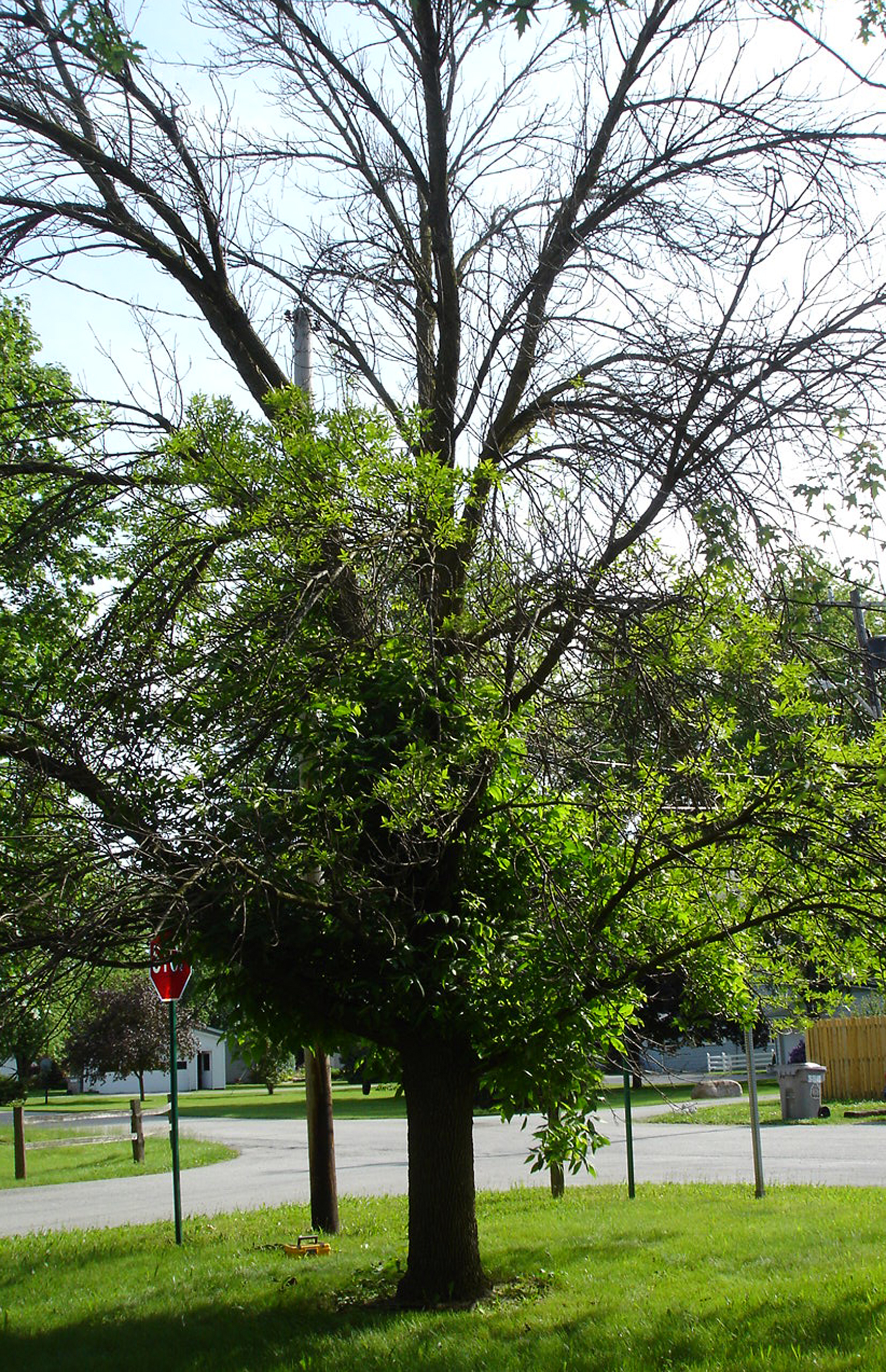Invasive species: The impact of Emerald Ash Borer
The impact of invasive species on native species is hitting close to home where I live right now. Ash trees (Fraxinus sp.) were popular shade trees in my area. However, that is changing rapidly. Wherever I drive, I see ash trees with dead tops and thick bunches of green leaves near the crotches of their main branches due to young sprouts. Classic signs of Emerald Ash Borer (Agrilus planipennis) infestation.
Ash trees make up ~10% of the trees in old-growth forests here. Yes, we still have some remnant old growth forest that was never cleared here. I know of three within a hour drive of my home in southwestern Ohio: the Wright State University Woods, Hueston Woods State Park, and Glenn Helen Nature Preserve. The loss of ash trees will have multiple ramifications for eastern forests.
The trees are important to many insect species, including
In short, there will be multiple consequences to losing ash trees from our forests, ranging from the immediate (less food available for multiple insect, bird, and mammal species) to the long-term (changes in tree species distributions, tree abundance, shifts in bird populations, insect populations, and succession patterns).
As you might expect, there are several projects underway to ameliorate the consequences. One, currently being done by our local parks district, is to select multiple trees of all ash trees that live in the area and inoculate them against Emerald Ash Borer. This inoculation program is pricy and must be repeated yearly. As such, there's no way that this is a long-term solution. The other I'll mention is underway as I type. Plant physiologists and geneticists are currently working to figure out why ash species from Asia (where Emerald Ash Borer originated) are not killed by the insects, identify the genes responsible, then insert those genes into the North American ash species. Something similar has been done via traditional breeding programs for American chestnuts (Castanea dentata) after the chestnut blight wiped them out, cross-breeding the survivors with the closely related Chinese chestnut, then crossing the most resistant offspring back into the American chestnut line, but that effort has literally taken over a century and is just now producing American chestnuts resistant enough to plant in the wild. It's hoped that by using genetic engineering, we can restore ashes on a much faster timescale.
More information:
Black ash
Green ash
Pumpkin ash
White ash
Emerald ash borer
 |
| Picture from https://news.uns.purdue.edu/images/2011/ash-dying.jpg |
Ash trees make up ~10% of the trees in old-growth forests here. Yes, we still have some remnant old growth forest that was never cleared here. I know of three within a hour drive of my home in southwestern Ohio: the Wright State University Woods, Hueston Woods State Park, and Glenn Helen Nature Preserve. The loss of ash trees will have multiple ramifications for eastern forests.
The trees are important to many insect species, including
- Tiger Swallowtail butterfly caterpillars (Papilio glaucus)
- Notched-Winged Geometer (Ennomos magnaria)
- Great Ash Sphinx (Sphinx chersis)
- Long-horn beetles (Cerambycidae)
- Metallic wood-boring beetles (Buprestidae)
- Bark beetles (Scolytidae)
- Leaf beetles (Capraita circumdata and Trichaltica scabricula)
- Black-Headed Ash Sawfly (Tethida barda)
- Brown-Headed Ash Sawfly (Tomostethus multicinctus)
- Oystershell Scale (Lepidosaphes ulmi)
- Leafcurl Ash Aphid (Prociphilus fraxinifolii)
- Meliarhizophagus fraxinifolii (an aphid)
- Ash Plant Bug (Tropidosteptes amoenus)
- Ash Bullet Gall Midges (Dasineura fraxinifolia and Dasineura pellex)
- Fringetree Lace Bug (Leptoypha mutica)
- Wood Duck (Aix sponsa)
- Wild Turkey (Meleagris gallopavo)
- Bobwhite (Colinus virginianus)
- Cardinal (Cardinalis cardinalis)
- Pine Grosbeak (Pinicola enucleator)
- Evening Grosbeak (Coccothraustes vespertinus)
- Purple Finch (Carpodacus purpureus)
- Red-Bellied Woodpecker (Melanerpes carolinus)
- Red-Headed Woodpecker (Melanerpes erythrocephalus)
- Pileated Woodpecker (Dryocopus pileatus)
- White-Breasted Nuthatch (Sitta carolinensis)
- Several species of owls
- Fox Squirrel (Sciurus niger)
- Red Squirrel (Tamiasciurus hudsonicus)
- White-Footed Mouse (Peromyscus leucopus)
- Woodland Deer Mouse (Peromyscus maniculatus)
- White-Tailed Deer (Odocoileus virginianus)
In short, there will be multiple consequences to losing ash trees from our forests, ranging from the immediate (less food available for multiple insect, bird, and mammal species) to the long-term (changes in tree species distributions, tree abundance, shifts in bird populations, insect populations, and succession patterns).
As you might expect, there are several projects underway to ameliorate the consequences. One, currently being done by our local parks district, is to select multiple trees of all ash trees that live in the area and inoculate them against Emerald Ash Borer. This inoculation program is pricy and must be repeated yearly. As such, there's no way that this is a long-term solution. The other I'll mention is underway as I type. Plant physiologists and geneticists are currently working to figure out why ash species from Asia (where Emerald Ash Borer originated) are not killed by the insects, identify the genes responsible, then insert those genes into the North American ash species. Something similar has been done via traditional breeding programs for American chestnuts (Castanea dentata) after the chestnut blight wiped them out, cross-breeding the survivors with the closely related Chinese chestnut, then crossing the most resistant offspring back into the American chestnut line, but that effort has literally taken over a century and is just now producing American chestnuts resistant enough to plant in the wild. It's hoped that by using genetic engineering, we can restore ashes on a much faster timescale.
More information:
Black ash
Green ash
Pumpkin ash
White ash
Emerald ash borer



Comments
Post a Comment